Intro
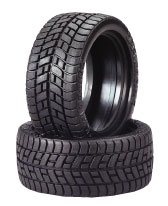
Now-a-days you hear and read a lot about tires in the magazines, at the
track, and on web discussion boards all over the world. What is it about this
topic that interests us racers so much? All your car has to prevent it from
sliding all over the track are those small areas underneath the tires.
Maximizing the traction on those four spots is what tire and car setups are
all about. Even if you have the perfect chassis setup and the best tuned
engine, without the proper tires, you won't be better off than if you used
Slick 50 as a traction additive!
There are many things that need to be considered to effectively select the
tires that are needed for your car to perform at its best. The first question
that you need to ask yourself is whether you are willing to sacrifice some
cash to get your sedan to hook up. I will be giving you some general tire
setup that will work for most surfaces. If you are willing to sacrifice some
longevity for enhanced performance, then let's get to it. No, I have not
forgotten about you the budget racer (I consider myself a racer on a budget).
I know tires are one of the most expensive items on a racer's budget,
especially if you run gas cars and routinely run 20 min Mains. Nobody likes
spending $40 on a tire set -to then find out that the car handles worse than
it did with run-down practice tires. That's why it's better to conduct an
experiment when you know the outcome. Always check with the racers that are
winning to get an idea of what types of tires work best at the track. There
is no sense in spending money doing tire R&D when the knowledge base is already
there. If the local racers are keeping you in the dark, then ask the Hobby Shop
sales associate; at least you'll know what tires are the big sellers. Just
remember that a little quick and painless investigative work up front can save
you a big headache in the future. When you do buy your tires, remember to throw
the junky open-cell foam insert that most tire manufacturers include with their
tires in to the trash-can and instead use molded foam inserts.
Identifying the Track Surface:

A tire is designed to be used at a certain temperature and surface. So the
first step in properly selecting tires is to correctly identify the surface
where you are planning on racing your car. Tires that work on a particular
track & temperature will probably not work or not work as well in other
conditions. It is not uncommon to have winter, fall/spring and summer setups.
As the temperature and track conditions change, some types of tires will
adapt better to the change than others. If you happen to run on a couple
of different surfaces you will probably end up with an optimal tire setup
for each track or you could shot down the middle and get a tire set that
will work on most of the surfaces.
|
CONCRETE
|
ASPHALT
|
|
ROUGH
|
SMOOTH
|
SEALED
|
|
|
UN-SEALED
|
|
CLEANED & BLOWED
|
W/TRACTION ADDITIVE
|
CLEANED & BLOWED
|
W/ TRACTION ADDITIVE
|
|
SMOOTH
|
BUMPY
|
SMOOTH
|
BUMPY
|
|
HOT or WARM
|
COLD
|
HOT ot WARM
|
COLD
|
Tire Terminology:

A quick brush up on tire terminology: There
are two main types of tires. These are rubber and foam tires. Rubber tires
are further separated into two categories, temperature rubber and traction
rubber. As the name implies, temperature tires rely on heat to soften the
tire. As the tire softens, it heats up even more, causing the outermost
rubber layer to break down generating hi-levels of traction. Traction rubber
tires rely on the softness of the tire and its adhesive quality to generate
traction. These tires feel very soft and sticky. With this type of rubber
tire, traction increases gradually with increased heat, but it's more related
to the softening of the rubber and not due to rubber break-down as is the
case with the rubber used for making temperature tires. Most of the traction
rubber tires are marketed as long-lasting or long-wear high traction tires.
Quick Asphalt Tire Setups:
For the best performance on asphalt, you will
need to run foam tires. This is especially true if you have serious HP
and the space to use it. When the temperature is right, there is no beating
foam tires on asphalt. Popular choices are reds, blues or double orange
in the front and orange, purple or pinks in the rear.
Temperature rubber tires in my experience seem
to work the best if you have to run rubber on asphalt. On asphalt
I would recommend Pro-Line S2 or H13 with a hard molded insert for the
front; and on the rear use S3 with a med./hard or med. molded foam insert.
If you are on a tight budget, Duratrax slick tires for the Street Force
GP are sold for less than $10 and that's for a full set of four temperature
tires!
Quick Concrete Tire Setups:
Traction rubber tires work very well on concrete.
As the heat factors increases, so does the traction level, but heat is
not as critical because the tire is already soft to begin with. If it's
too hot (in the upper 90's), then you might need to go with a slightly
harder compound tire or a belted one. You may also need to increase the
hardness of the insert to help the tire retain its shape a little better.
If temperatures are right, you can get better traction with a temperature
rubber tire. If that is the case, then a H13 with a hard insert in the
front coupled with an S2 with a hard insert in the rear should provide
increased performance.
Tire Setup Theory:

The golden rule: Tires are 80% of a car's setup.
You could play with your suspension for a week straight until you get the
car to go around the track without spinning the rear end. You could also
take your wheel wrench and change the tires in under a minute and have
a better handling car -It's your choice…
It's true, for an ill handling car, a tire change
would be the easiest but not the most cost-effective way of getting the
car to handle properly. Even if you make a tire change, it probably won't
get you 100% of where you need to be. You still need to work on overall
chassis setup; but even this is secondary to having the right tires. If
there is a big flaw on your chassis setup, then a tire change is not going
to save you, at least not enough to get you anywhere near the A-main.
Some people have the philosophy that you
must learn to drive a car that oversteers severely and will spin out the
moment you touch the steering wheel. Others, consider it normal for the
car to plow through the corners and grab a handful of wood every time you
enter a corner at more than 5 mph. Folks, I'm going to let you in on a
secret: If the D-main drivers traded cars with the A-main drivers,
they would probably do a whole lot better. I can't do well in a race unless
my car is easy to drive. The fact is that if I can drive it to the finish
line, then the average racer would do even better than I -with my
own car! Driving is important, but having a well-behaved car is also a
big part of the winning equation.

Effects of Chassis setup on Tire Selection
Chassis Setups:
Lately the "hot" setups for the latest breed of
"racing" sedans (insert your car here)... is ultra stiff suspensions w/
super thick anti-roll bars, front one-ways and solid rear diffs. If you
have foam tires and a track that is oozing out traction additive -maybe.
If you have a great computer radio and a degree in computer programming
and are a very smooth driver, then this is a good setup! The only bad part
of these new stiff setups is that it makes the car super twitchy and you
can't make any mistakes in the driving department. Try this setup w/ the
wrong tires or on a rough track that needs the suspension to work and your
car will be everywhere on the track. You will make the boards your home.
Not only that ,you will look like a fool doing doughnuts in the straight-a-way
with a "race" car.
If you just recently got your car and don't have
it hooked up, the last thing you need is an ultra responsive stiff suspension.
You need a car that's forgiving and that you can get used to. You also
need a car that understeers a little and pushes slightly when on power.
This type of car anyone can drive; it's consistent and less error prone
than the twitchy stiff chicken.
How do I get my car to handle like that?, you may
ask yourself, as your car grabs another handful of 2X4 wood...there goes
the shiny aluminum turbo fast suspension arm set (Wasn't the aluminum junk
supposed to make me faster -you thought?)
To get a car that's easy to handle, you need to
get the suspension to work smoothly. The front always must be stiffer than
the rear. The shock oil must always be thicker in the front. Also, the
front tires must have less grip than the rear. This is achieved by using
a stiff insert in the front and a softer one in the back. Many times you
will need to use different tire compounds between the front and the rear.
What matters is that you have consistent front-to-rear traction. You need
to know exactly how the car is going to behave when you're braking, accelerating,
taking a fast corner or a slow one. For you to feel comfortable with your
car, it has to feel consistent at all points in the track.
Don't forget that if you start with the manufacturer's suggested setup,
then choosing the proper tires will get you 80% toward that "perfect" setup.
The rest is chassis fine tuning...Bare in mind this is assuming you have
everything under "control" in the driving department.
Solving Common Handling Problems
Oversteering:
The most common problem that racers run into is
that their car oversteers. This means that the car over-reacts when you
try to turn the front wheels. As a result of high levels of front traction
the rear brakes loose and wants to trade places with the front whenever
you ease up on the throttle and try to turn the front wheels. Let's have
a quick top level look at how to correct this handling problem. Some cars
seem to work well with the same tire/insert combination at all four corners,
but most cars will tend to have varing levels of oversteering when this
is attempted.
(Oversteering) Primary Change:
Change front tire to a harder one (less traction)
or go to a softer rear tire (more traction). Don't waste your time and
money on trying to correct a severe error in tire choice with suspension
adjustments. If the tire selection is "way" off, then do yourself a favor
and change the tires. You can always use the offending set as play tires
or for breaking-in new engines at a parking-lot. Sometimes when tire choices
are very limited I suggest you swap out the tires, front to rear(assuming
you have different compounds). On some occasions this works real well,
on other the problem is reversed ie. the car goes from oversteering to
understeering.
(Oversteering)Secondary Change:
1. Reduce steering servo travel (throw).
2. Set front camber to –0.5 and rear camber to -1.5 .
3. Increase front caster if you need to take-away
low-speed steering. Reduce front caster if you want to remove high-speed
steering.
3a. Increase rear toe-in to add on-throttle stability.
3b. Increase front toe-in (will make steering
less responsive at the beginning of a turn).
4. Decrease chassis droop or down-stops on car
(more suspension travel will get the car to roll more and be less responsive).
5. Increase front ride-height and/or lower the
rear to get more static weight on the rear tires.
6. Increase the shock oil viscosity in the front
to get less steering in the middle of the turns.
7. Go w/ stiffer springs in the front shock and/or
install front anti-roll bar. Go to the next softer spring in the rear shock.
Body roll creates traction. Too much body roll promotes instability and
roll-overs.
8. Reduce front differential action by tightening
the ball differential. If your car has a gear-diff, you can use thick silicone
diff fluid or heavy high-temp grease to slow-down power transfer. A tight
front diff will make the car push a little under power, thus making the
car easier to drive. You want the rear diff to be fluid, so that you can
send power easily to either rear wheel.
Understeering:
If the car understeers, this means that the car
is not responsive to your attempts at rounding the corners. The car plows
through the corners, with no front grip until: A) The car slows down enough
for your front tires to grip, or B) You hit a board and your car ricochets
into the corner (sort of like playing billiards with a $300 r/c car). To
fix this handling ailment you need to increase front traction and/or reduce
rear traction. Basically, do the opposite of the changes outlined in items
1-8. Sometimes when tire choices are very limited I suggest you swap out
the tires, front to rear (assuming you have different compounds and/or inserts).
On some occasions this works real well, on other the problem is reversed
ie. the car goes from understeering to oversteering.
Unresponsiveness:
If the car feels unresponsive to steering inputs
and easily brakes the rear loose in the corners -and your suspension is
not ultra-stiff, then it's time to change to stickier tires (tires
that provide more grip)
This is just a general guideline. Don’t make too
many changes at once; then you won’t know exactly what fixed your problem.
I read this piece of advice some time ago, and it’s helped me quite a bit:
“Work on the side of your car where the problem is first”. If you need
more rear traction, work with the rear end first. If after making the changes
you still need more traction, then remove some traction from the front.
Don't forget it is all a balance, the car will not work properly unless
you have the right amount of front to rear traction.

Rubber Tires
Intro:
I remember the days when "racing" tires would
last a couple of runs. The tires would develop a bald spot, or the soft
foam-insert would shift inside the tire and wear a groove around the inside
edge. These days, the one-run tire is a thing of the past. I'm a little
smarter with insert selection, and tire technology continues to move forward
at an alarming pace. Now, most of my tires out-live the rims they are mounted
on. That's actually a great feeling… The only draw-back of these new breed
of tires is that the new mold-releasing agents make the tires harder to
glue on to the rims. This means you have to be more careful about tire
preparation and the glue used on the tires needs to be of high quality.
To help the glue do its job better, clean the tires and wheels w/ motor
spray or denatured alcohol and make sure the insert and tire are seated
correctly. There is also the problem that with an overwhelming number of
different tires and compounds, belted and un-belted and more types of inserts
than flavors in a Baskin-Robbins… Soon enough you will not be better off
with 20 sets of tires than you were when you had 3 sets. I have so many
choices in my tire suitcase, that sometimes, even I forget what tire insert
combination has more traction than another… and, yes, it's all about traction!
Traction Rubber Tires:
The traction tire is of the type that does not
depend on the temperature to soften the rubber to increase traction. Traction
rubber feels sticky and will hook up immediately when the tires hit the
track, thus warmup is usually not even needed. Adhesion is achieved by
molecular bonds between the tire and the track surface. Examples of these
tires are Pro-Line H13, Take-Off's WSA,WSB,A25,B30 Panther's LP230,231
and other soft rubber long-lasting tires. Most of the major tire
manufacturers have some version of these long-lasting rubber tires. These
tires will last "forever". I have still to wear out an H13 with a
properly selected molded insert. I have H13 tires that have been commissioned
for almost a full year; the rims are a little beat up, but the tires are
like new... Traction tires perform well in colder climates because they
do not rely on heat to develop grip. Depending on your location, there
are some tires that can be run the entire season. Traction tires work very
well on unprepared concrete, even if it’s a bit dusty. They are not the
best for unprepared asphalt, but with a lot of tuning experience, you can
make them work in the tar tops. Because of their high traction and decreased
wear, these are great nitro sedan tires.

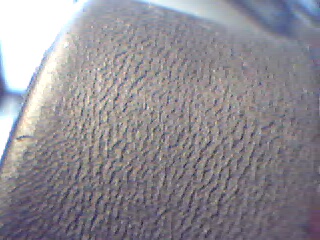
On the pictures above,
you will notice that small scores or ridges are actually formed on the
tire's surface. These are the typical wear patterns that you
will see on temperature tires. Notice that the tire's surface remains
clean and that the wear patterns have actually increased the tire's gripping
ability. The tire shown on the right is a very well worn Take-Off WSA tire.
It has been seeing racing action since last year. Shortly after the photo-shot
the tire was retired to provide a good shot of the inside of a belted tire.
A moment of silence for this battle hardened tire...All in the name of
Science.
Temperature Rubber Tires:
Temperature tires rely on the track and rubber's
temperature to make them stick. You can recognize these tires by the characteristic
thermal break-down of the rubber. It looks like the rubber is literally
burning off the tire and clinging to the tire's surface. Examples of these
tires are Proline's S2,S3... HPI Pro-Compound, etc… In the winter months
these tires don't work very well because the lower temperatures prevent
the rubber from breaking down. When the track starts to heat up, they work
very well. The hotter the tire, the more traction they give; heat is this
tire's friend! The only draw-back is that if the heat level is too high,
the tire will get oily and lose some grip. Also with increased heat levels,
tire life is sacrificed. Tire longevity is really the only drawback of
the temperature tire. Seeing how the tire consumes itself to provide traction,
this should not be a surprise. Tire durability issues are further enhanced
when the tire has some type of tread pattern or grooves cut into the tire
carcass. These patterns prevent the melted rubber from sticking to the
tire which will accelerate wear because the tire is continously exposing
fresh rubber. Temperature rubber tires perform well on both concrete and
asphalt surfaces. If the temperature is right, this tire will
give you the best traction (when compared with other rubber tires). When
the track is a bit dusty, temperature tires take a perfomance hit because
dirt gets stuck on the tires.

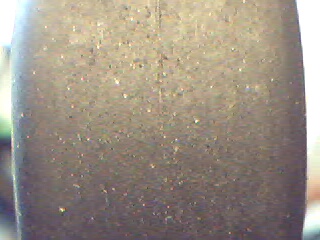
In the photos above,
you can see that the tires have picked up quite a bit of track debris.
On the left(Panther Firm-Compound LP Slick), you can make out the
small pieces of rubber that are clinging to the tire's surface. This broken-down
rubber gives the tire its characteristic tacky feel.
Hybrid Rubber Tires:
The third and last type of tires are Hybrid tires.
These basically borrow some characteristics from both the temperature tires
and traction tires. An example of a combination tire is HPI’s B1540 tire.
They are good choices if you run in varied surfaces and don't want to spend
a bunch of money. They are also good because they tend to outlast the temperature
tires, yet still retain some of their properties. Many of the new breed
of long-lasting rubber tires actually are part of this hybrid group.
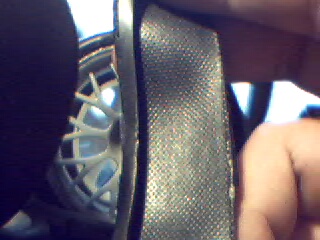
Here we show the inside of a Take-Off WSA
belted(radial) tire. The fiber-belt is permanently bonded to the rubbers
surface.
I haven't talked much about other tires that have
special treaded patterns or are belted. Belted tires tend to last longer
than unbelted tires, especially if they are temperature tires. Temperature
tires get softer as they heat up; the tires balloon a little when you accelerate.
This can accelerate wear and cause the car to feel inconsistent. On real
hot days the car seems to hop in the corners. This isn’t always a
huge performance hit; just remember that when the tire’s diameter changes,
this can cause the car to have over/under-drive. This could accelerate
wear-and-tear on the car's drive train. You should not use a high level
of over-drive unless your car has a one-way bearing. Over-drive helps you
get out of the corners when you’re on the throttle. You don’t really want
under-drive or your rear end is going to slide when under power.
Tire Temperature Ratings:
Some of the newer breed of tires are coming out
with temperature ratings. This is but another way of fine-tuning the traction
level to the track conditions. Does this mean that you can't use a cold
weather tire on a hot day? No -but you won't get maximum grip. With some
rubber compounds, as their temperature goes up in the warmups, the traction
will either increase, stay the same or it will be reduced very quickly.
Be on the lookout when the car suddenly starts to act funny, and at what
point in the race it starts happening. This is normally the case when you
had great traction in the warmups, and then the traction just vanishes!
This loss of traction is mainly caused by the gradual increase in tire
temperature over a period of time. When you are practicing, take your temp
gun and aim it at your tires every couple of minutes until you reach maximum
temperature. Typically, tire temps will be 15-20F higher than the ground
surface. Make track/tire temp readings a regular part of your setup notes;
getting to know how temperature tolerant your rubber tires are will help
you make the right tire choices even before you set foot on the track.
Molded Inserts:

Molded
inserts come in many flavors. There are three characteristics that need
to be mentioned with inserts: 1) The firmness of the foam material
used to make the insert. Typical nomenclatures for foam density are soft,
soft-medium, medium, hard/firm, extra hard/firm. 2) There is also
the width of the insert. Most narrow or medium-narrow inserts are for 24mm
tires. Most of the time these can be used on std. 26mm rims and LP tires
without many problems. The low profile std. 26mm inserts are a little bit
wider. They will give you a slightly flatter contact patch. 3) Last
on the list is the thickness of the insert. The thickness will depend
on the following tire carcass design attributes: Standard, Low-Profile(LP),
Extra Low-Profile(LP2), Round and/or Belted. Note: Some of the newer Losi
LP and Pro-Line LP2 are of the extra low-profile type of tires. These require
the use of very thin molded inserts. The Std. 26mm thick insert was designed
for full height tires. Most of these tires are now extinct because racers
have switched over to lower profile tires that have less side wall flex
and also give the cars a lower ride height. Make a mental note: Most of
HPI's tire line-up still needs a std. thickness insert to fill the tires
taller profile. Because HPI's 24mm tires are both narrower and taller than
other tire types it may be difficult to find molded inserts that fit the
tire properly.
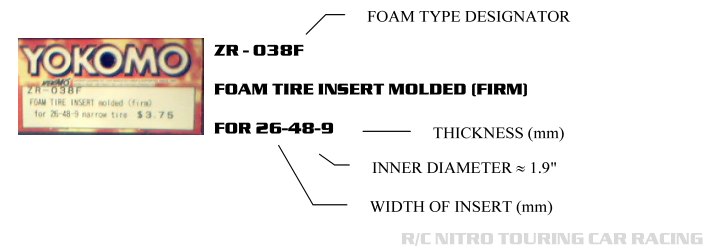
Here we explain the specs on Yokomo ZR-038F
molded insert. Notice the (3) mm dimensions on the lower left-hand side
of the label.
The most important part of selecting an insert
is that the tire is properly supported and that you don't have too thick
or too thin of an insert. Either condition will yield inconsistent traction.
The profile of the insert is also important. A flat tire will yield more
straight-line traction, but a round tire will react better on the corners;
it's all a compromise.
Misc. Information:

Most
24mm tires can be used on 26mm rims and visa-versa. There is so much variation
on what manufacturer "A" calls 24mm and what manufacturer "B" calls 24mm
that nine out of ten times, the tire will fit on either 24/26 rim with
no objections. The insert is really more important than the rim's width.
The softer the tire, the harder the insert. Typically, the front tire has
a relatively hard insert to help reduce front traction. Don’t use the spongy
open-cell foam that most tire manufacturers include w/ their tires. Sponge
inserts don’t work that well, especially when trying to support the weight
of a heavier nitro sedan. Instead, buy molded inserts that help keep the
tires' contact patch in good shape. The end-effect is that your tires will
give you better and more consitent traction and will last twice as long.
Rubber Tire Overview:
To wrap up the rubber tire section, some brands
do work better than others, but you’ll have to experiment to see what works
for you. I currently use Pro-Line, HPI, Duratrax Take-off and Ofna tires.
These are just a small number of the many companies selling tires and inserts.
I know a lot of people that swear by (insert other tire manufacturer here).
All I can say is that I’ve spent a lot of money on tires and inserts and
I can only comment on the tires that I have used. If you follow the manufacturers
application chart and select a good insert, then you will probably get
good results and long tire life. Make a handful of setup changes and you’ll
have a great handling car.
Hot Track Tire Experiments:
Recently, I brought my entire tire suitcase to
the local track on a hot 95F day, with only one thing in my mind -Tire
setups. Swapping tires actually became my primary mode of operation. If
the car and tire setup worked, that was great! I changed tires... If the
car didn't work not so great, I tried other tires...The number one
thing that I noticed was that cool or mild-weather traction tires would
not really wear out, even if you cooked the tire to 130F! What actually
happened was that the tires lost their grip, some by a large margin. This
usually wasn't apparent until the car had been on the track for at
least 3-5 min. During this day-long experiment, there was one tire compound
that I kept reaching for: it was the H13 with a 26mm hard insert.
I have a group of H13s that I've been using since last summer/fall. It
has been my experience that this tire is not suited for the rear because
it lacks the necessary grip, but as front tires H13 shine! My testing
has confirmed that H13 tires are very temperature tolerant. They
work at 60F, and also work at 130F; few tires on the market are as versatile
as the Proline's H13. They seem to work best when kept closer to 100F,
but they are still functional and long-lived for summer racing too. With
a properly selected rear tire you should be able to continue to be competitive
at the local track during the entire season. Seeing how the H13 is very
popular as a control tire for the some of the big National races; this
news should not be a huge eye opener. The Texas summer is long and very
hot; hopefully, as the season unwinds, I'll have more hi-temp data to share
with you.
Panther LP-Slick Tire Review:
A short time ago i decided to take the plunge
and try-out the new Panther Sedan LP-Slick tires. After a few testing sessions,
I'm not impressed with their hot weather performance. Most manufacturers
give you an idea of the temperature rating of the tire. I prefer traction
and temperature ratings on tires; this takes some of the guess-work out
of choosing tires. HPI, Sorex, Take-Offs and Even Pro-line, to a small
extent, have been doing this for some time now. Panther tires should have
gotten on the bandwagon; instead, they went with soft, Med/Soft and Firm
compound labels (It sort of leaves you in the dark as far as application
temps are concerned). With the softest tires in the rear and the med/soft
compound in the front, the car was planted. After the warmup, the rear
tires lost their grip; shortly thereafter, the car was pushing under-power
and I was losing the rear in the turns; It was "spin city..."
I decided to experiment with other combinations, so I changed to firm in
the front and med/soft in the rear. The car handled better, but the med/soft
tire lost its grip after the warmup; and again, it was "spin city". I tested
the "firm" tire compound in another occasion and again handling was not
to par with other more popular tires on the racing circuit. From the way
the car handled it seemed that the rubber compound that Panther used to
mold the tires is not suited to very hot temperatures. During testing tire
temps peaked close to the 130F mark. After a few 5 minutes runs tire wear
seamed to be taking it's toll on the firm tires. It's interesting to note
that the softer panther compounds seemed to wear more like traction tires,
whereas the firm tire was wearing very similar to a Pro-Line S2/S3 yet,
yielded less traction. It was very apparent that the tires were not at
home under the hot Texas sun, who knows? Maybe these tires will be the
hot ticket in the fall when it cools down a bit. I'll keep you posted...
Wrap-up:
This is only the first
part of this two(2) Article Series. Stay tuned for the next major portion
of this article: The Sedan Foam Tire. Foam tires are a completely different
beast when compared to rubber tires. We will cover this topic in great
detail in the next installment of this Mega-article. Until then...
Whoop some R/C car butt!!!
Eric Perez
Team NitroRC.com
If you have any questions or would like to discuss
any of the topics presented in this article, feel free to
e-mail me.

![]()